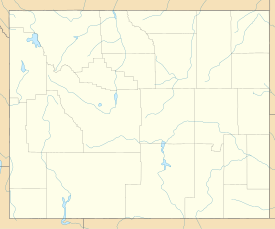Fort Phil Kearny
| Fort Phil Kearny | ||
|---|---|---|
| National Register of Historic Places | ||
| National Historic Landmark | ||
|
Plan of Fort Phil Kearny, 1904 |
||
|
|
||
| location | Johnson County, Wyoming | |
| Coordinates | 44 ° 31 '56.5 " N , 106 ° 49' 35.5" W | |
| Built | 1866 | |
| NRHP number | 66000756 | |
| Data | ||
| The NRHP added | October 15, 1966 | |
| Declared as an NHL | December 19, 1960 | |
Fort Phil Kearny is a former military post in the US state of Wyoming . It was built in 1866 to protect travelers on the Bozeman Trail, to prevent wars between the Indian peoples of the region and to divert the attention of hostile Indian groups from the establishment of the transcontinental railroad further south. It was named after the US General Phil Kearny . Since December 1960, the fort and other historical sites in the region have been designated as a National Historic Landmark under the name Fort Phil Kearny and Associated Sites .
location
The fort was built at the junction of Little Piney Creek and Big Piney Creek. It was the largest of the three military posts on the Bozeman Trail; to the northwest was Fort CF Smith and to the southeast was Fort Reno .
Today Fort Phil Kearny is located on Interstate 90 , between the cities of Sheridan and Buffalo , near Lake DeSmet .
history
In July 1866, the 18th US Infantry Regiment built the military post as a palisade fortress. Colonel Henry B. Carrington was in charge of protecting the Bozeman Trail ; Fort Phil Kearny served as his headquarters. The length of the fort was 456 meters (1496 feet), the width between 73 meters (240 feet) in the south and 183 meters (600 feet) in the north. Over 4,000 tree trunks were necessary for the construction. It was constantly expanded over the next two years and should ultimately be able to accommodate a crew of 1,000.
The fort was in the last major Bison of -Jagdgründen Lakota - Arapaho - and Northern Cheyenne - Indians , who felt threatened by the military post. As a result, there were several fighting in the area around the fort between US soldiers and warriors of the three allied Indian peoples, which went down in history as the Red Cloud War , named after the Oglala -Lakota- chief Red Cloud .
On November 3, 1866, the almost 400-strong crew of Fort Phil Kearny was reinforced by 63 soldiers under Lieutenant Horatio S. Bingham . The reinforcements included the three officers William Judd Fetterman , James W. Powell and Henry Almstedt . On December 21, 1866, warriors of the Lakota, Arapaho and Cheyenne destroyed 79 US soldiers and 2 civilians under the command of Fetterman (see Fetterman battle ). On August 2, 1867, 26 US soldiers and 6 civilians under James W. Powell successfully repulsed several hundred Lakota warriors. This battle went down in history as the Wagon Box Fight .
In 1868 the Bozeman Trail was made obsolete by the Union Pacific Railroad . In August 1868 the US military units withdrew because of this and because of the permanent state of siege by hostile Indians from Fort Phil Kearny, a little later it was burned down by Cheyenne warriors. In the Treaty of Fort Laramie 1868 , the United States assured some groups of the Lakota, Dakota and Arapaho extensive areas and the permanent abandonment of the Bozeman Trail and the three forts.
Fort Phil Kearny and Associated Sites
Under the name Fort Phil Kearny and Associated Sites , the fort was designated a National Historic Landmark in 1960. It includes remains of the former military post and a visitor center with an exhibition. The National Historic Landmark also includes two nearby theaters of war, the site of the Fetterman Battle and the site of the Wagon Box Fight. The fort has been listed as a site on the National Register of Historic Places (NRHP) since October 1966 .
literature
- Paul Williams: Frontier Forts Under Fire: The Attacks on Fort William Henry (1757) and Fort Phil Kearny (1866). McFarland, Jefferson 2017, ISBN 978-1-4766-7093-5 .
Web links
- Website at the National Historic Landmark Program (Engl.)
- Website at Wyoming State Parks Historic Sites & Trails (Engl.)
- Fort Phil Kearny / Bozeman Trail Association
Individual evidence
- ↑ a b c d Fort Phil Kearny Historic Site. (No longer available online.) Wyoming State Parks Historic Sites & Trails, archived from the original on May 3, 2014 ; Retrieved May 3, 2014 .
-
^ Fort Phil Kearny and Associated Sites. (No longer available online.) National Historic Landmarks Program, archived from the original on March 12, 2007 ; Retrieved May 3, 2014 . Listing of National Historic Landmarks by State: Wyoming. National Park Service , accessed March 14, 2020.
- ↑ a b Berndt Banach: The battle of the hundred slain. In: Magazine for American Studies, Issue 3, 1996.
- ^ Shannon Smith: New Perspectives on the Fetterman Fight. Wyoming State Historical Society, accessed May 11, 2014 .
- ↑ Fort Phil Kearny and Associated Sites on the National Register of Historic Places , accessed March 14, 2020.


